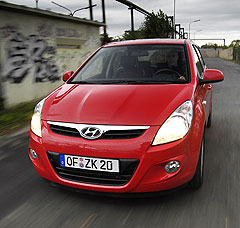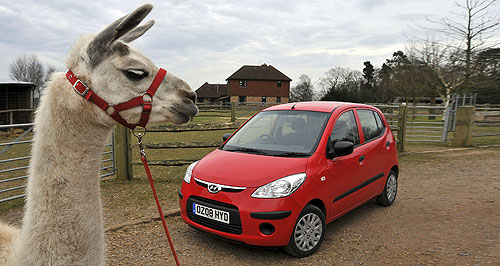Future models - Hyundai - i10Hyundai minis lost in translationStuck in neutral: The Hyundai i10 is in limbo until shipping and related issues can be resolved. Shadow on Indian-built Hyundai i10 and i20 over shipping, currency24 Jul 2009 By PHILIP LORD HYUNDAI Australia’s plans to import its sub-light i10 and light i20 hatches from India have hit a speed bump due to what the company says are the complexities of building a Korean car in India and shipping it to Australia at the right price. Hyundai still hopes to get the cars here towards the end of the year, but Hyundai sales and marketing director Kevin McCann says: “That is becoming something quite hard to achieve. “The i10 and i20 are built up from primarily Korean parts in the factory in India, making it difficult to set an exchange rate, and as there is no viable direct shipping available from India to Australia, costly shipping via a third country might have to be taken. “There’s a lot of movements on the cross-rates, so we’re trying to find the right formulation to position the FOB [free on board] pricing at. So it’s a three-way negotiation rather than the normal two-way.” Mr McCann said there was no direct shipping route for roll-on, roll-off vehicle transport from India to Australia. He said Hyundai would have to tranship via another port for at least the first few months, at extra cost.  Left: Hyundai i20. Left: Hyundai i20.Two other manufacturers already do this. Mahindra ships Australia's first Indian-built vehicle, the Pik-Up utility, via Singapore or Hong Kong, while Australia's first Indian-built passenger car, the new Suzuki Alto sub-light hatchback launched just this week, comes via Singapore. Mr McCann said Hyundai had to decide if it would incorporate the transhipment cost burden into the car, “depending on how we see the future of the car and our ability to convert to direct shipping at a later stage in the life cycle”. “The ship’s going to have to go from India to perhaps, for example Korea, where the ships are going back to, and then unload the cars on a wharf there and reload the cars on a ship that’s coming down to Australia, full of other cars. “A back-loaded ship is normally empty, so it doesn’t normally have the same factor as the normal shipping but there’s still a cost involved in loading and unloading.” With such sensitive pricing in the sub-light and light car market, Hyundai wants to get off on the right foot with what it considers vital cars for its future. “The decision we face is, do we take a hit up front, and anticipate we’re going to have a lower cost in the near future, or do we pass it on up front because we know it’s never going to change,” Mr McCann said. “We have to decide for how long does it have to be that way before volume is sufficient for us – perhaps not to fill ships – but sufficient for them to make a voyage from India to Australia.” While a Hyundai Australia team arrived back this week from negotiations with head office in Korea, Mr McCann says he doesn’t know the outcome as yet and suspects there will be no resolution just yet to the impasse. “They’ve only got back this morning, and we haven’t got our heads together, so I don’t know at this stage [and even if known] that doesn’t necessarily mean that we’ll come to a decision in the next few days. “It’s just a matter of passing to another stage of the discussion. I don’t know how far along that takes us in terms of the progress we have to make.”  Read more24th of July 2009  Keen prices keep rivals on the hopAlto, Getz slug it out at for 'Australia's cheapest car’ monniker9th of June 2009  Good Korea moveHyundai targets Mazda in Australia as global onslaught lifts market shareAll future models Alfa Romeo Alfa Romeo Abarth Abarth Audi Audi Aston Martin Aston Martin BMW BMW Bentley Bentley Chrysler Chrysler Chevrolet Chevrolet Dodge Dodge Citroen Citroen Ferrari Ferrari DS DS Ford Ford Fiat Fiat FPV FPV Foton Foton Haval Haval Great Wall Great Wall Honda Honda Holden Holden Hyundai Hyundai HSV HSV Isuzu Isuzu Infiniti Infiniti Jeep Jeep Jaguar Jaguar Lamborghini Lamborghini Kia Kia Lexus Lexus Land Rover Land Rover Mazda Mazda Maserati Maserati Mercedes-Benz Mercedes-Benz McLaren McLaren Mini Mini Nissan Nissan Mitsubishi Mitsubishi Peugeot Peugeot Opel Opel Proton Proton Porsche Porsche Renault Renault Ram Ram Saab Saab Rolls-Royce Rolls-Royce Smart Smart Skoda Skoda Subaru Subaru SsangYong SsangYong Tesla Tesla Suzuki Suzuki Toyota Toyota Volvo VolvoMotor industry news |
Click to shareHyundai modelsResearch Hyundai All future models Alfa Romeo Alfa Romeo Abarth Abarth Audi Audi Aston Martin Aston Martin BMW BMW Bentley Bentley Chrysler Chrysler Chevrolet Chevrolet Dodge Dodge Citroen Citroen Ferrari Ferrari DS DS Ford Ford Fiat Fiat FPV FPV Foton Foton Haval Haval Great Wall Great Wall Honda Honda Holden Holden Hyundai Hyundai HSV HSV Isuzu Isuzu Infiniti Infiniti Jeep Jeep Jaguar Jaguar Lamborghini Lamborghini Kia Kia Lexus Lexus Land Rover Land Rover Mazda Mazda Maserati Maserati Mercedes-Benz Mercedes-Benz McLaren McLaren Mini Mini Nissan Nissan Mitsubishi Mitsubishi Peugeot Peugeot Opel Opel Proton Proton Porsche Porsche Renault Renault Ram Ram Saab Saab Rolls-Royce Rolls-Royce Smart Smart Skoda Skoda Subaru Subaru SsangYong SsangYong Tesla Tesla Suzuki Suzuki Toyota Toyota Volvo VolvoMotor industry news |
















Facebook Twitter Instagram